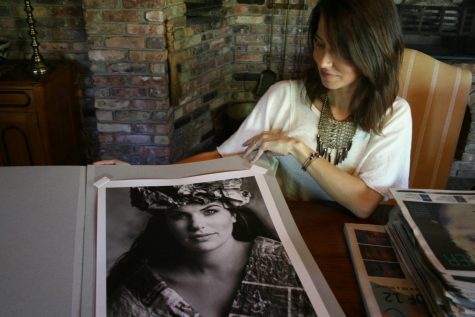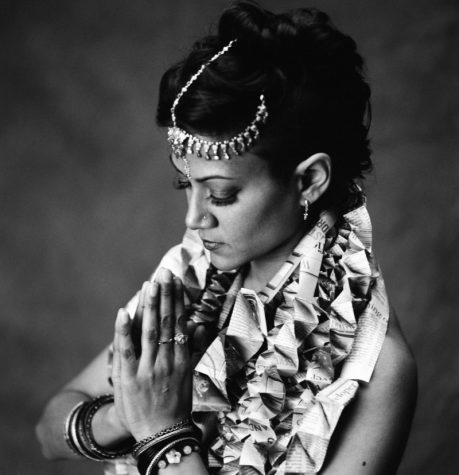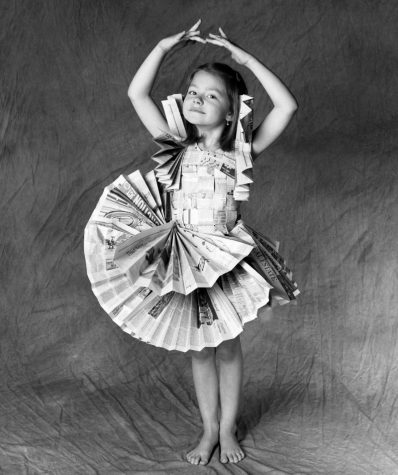Zlatka Burtis: turning the old into new
May 15, 2017
Zlatka Burtis came to the U.S. from the Czech Republic on a whim when she was 20 with a six-month visa. She knew nobody. She knew no English. She took to the College of DuPage for her education, and 17 years later, she owes it to the college for teaching her the language, and now, helping her develop her skills as an artist.
“Newspaper Dolls” is Burtis’ latest project, a new art form she discovered in the 2014 Fall semester during an independent study. The project consists of all handmade dresses, skirts and accessories created from newspaper. Then Burtis stages photoshoots for the pieces on models where she uses a film camera to capture the pieces. The last step is developing the negatives and hand painting them to provide a contemporary, borderline pop art appearance.
Burtis was asked to present three dresses in the upcoming fashion show, one of them to be made from Courier newspapers, and has had a newspaper gown on display in the President of the college’s office. Currently, one of her handpainted “newspaper doll” prints is hung in the Cleve Carney gallery.
Fashion was not what Burtis focused on at first. Drawing, though she admits she doesn’t consider herself a talented drawer, was her first artistic love. That grew into painting. Then photography became her favorite medium.
“I wouldn’t call myself a photographer,” said Burtis. “I don’t like to be labeled. I rather choose artist. General. That’s what I like to do: create. And I use the camera to create art.”
Fashion was always something she loved but oftentimes never got to explore in her younger years in the Czech Republic.
“In Czech, I grew up in a communist country,” explained Burtis. “There wasn’t much fashion back then. My mom made our clothes. She made our winter coats, my dresses, that’s how I grew up.
“At that time, I didn’t appreciate it,” she continued. “Now looking back when I have my kids, I understand it more. I never wanted to wear it. My friends didn’t. Why did I have to wear it? My mom was telling me, ‘One day, you will wish that you know how to sew.’ I said, ‘No, no.’ Now I really wish I knew.”
Because Burtis doesn’t know how to sew, using newspaper is the perfect in-between for her to design and create fashion in her own way. She could take classes to learn, but she would much rather focus her time on designing the pieces rather than creating them. Newspaper gives her the opportunity to be hands on in ways she couldn’t otherwise.
Burtis always had the mind of an artist. I could easily see her artistic mind when entering her home, looking at her studio filled with various newspapers in different folds. A huge canvas facing the open windows that filled the room with rays of light, displaying the beginnings of a watercolor portrait. Her desk, covered in various ideas, facing a beautiful, lush outdoor garden. But back when Burtis was 20 and graduated, she began working for a woman in a flower shop in Prague. But it wasn’t enough for her young and free, artistic spirit.
“I started working there and was like, ‘I guess that’s what life’s about, right? Going to work and that’s it,’” said Burtis. “I felt like, ‘No. I don’t want to live like that. I want to travel.’”
Burtis applied for a six-month visa when a friend who decided to sell his house in Darien, Ill. and asked Burtis if she’d want to come back and visit for two weeks before they left. She never even hesitated to agree when asked. One visa turned into another six-month visa, which then turned into winning a green card lottery, turning the U.S. into Burtis’ new home.
Winning a green card was life-changing for Burtis. “I couldn’t believe it,” she said. “I got the papers and thought, ‘OK. This means something.’”
When Burtis made the decision to stay the full six months, she wanted to educate herself, get a job, and support herself in any way she could. For three years she took English as a second language courses at the College of DuPage. Once she became confident in her abilities, she began taking science and math courses. Though she successfully passed, she quickly learned they were not the types of classes she wanted.
Instead, she began taking art classes. The very first one was a photography class, though she was initially reluctant. She thought she knew her film camera, and didn’t need somebody to teach her, but after the first class she wanted to take more and more.
“I think I’ll be a student for all my life at COD,” said Burtis. “There’s still so many classes I want to take. I actually love COD. I love the art department, the photo department. Every instructor there, every professor there, I feel like I’m at home. It’s family-like.”
In a portrait class, when given the subject “fashion,” Burtis kept dreaming of designing her own pieces. Over time, Burtis has developed the “newspaper doll” project into a lifelong project. Initially it began as attempts with wrapping paper, but something about the images, the words, and the structure of a newspaper was everything she was looking for. She has begun to master each detail, each fold, to turn the vision in her mind into the paper.
Her mind is eternally running with ideas. She admits she doesn’t look anywhere for inspiration besides her own work, or instead looks for inspiration to help her create her visions.
“I walk away from it, but my mind is still processing, still creating a vision of the dress,” said Burtis. “It’s like I walk away, but it’s still in my head. I’m still thinking. Then I go back to the mannequin. I start placing paper, and many times I end up doing something totally different. It just works in a different way, and I find a new way of doing it, and I’m excited. If I don’t want to use it for that dress, I write it down in my journal for next time, or I take photos of folds I want to use for next time.”
The model, to Burtis, is just as important as the work. When showing me a large wire hoop handmade and wrapped with ribbons, sharing how she’s wanted to create a huge, layered skirt, I question why she hasn’t attempted something she’s been itching to do for two years.
“I haven’t found a model,” she replies.
For Burtis’ first piece, a skirt, it was the look on her model’s face when she first put on the skirt that drove Burtis to continue.
Burtis admits to being extremely detail-oriented and a perfectionist. She looks for everything that will help create the perfect vision, especially the model. Her models range from her daughters to women she has seen in passing, but when she sees somebody to fit the perfect piece, she must photograph them.
“There are days I go through my photos. I go through my negatives, and sometimes I feel, ‘This is all garbage. I see nothing in it. Everyone can do that,’” said Burtis. “I call them ‘dark days.’ They come to me. They haunt me sometimes. But then the next day I think, ‘You can do it! Of course you can do it.’ It’s hard to be an artist, but I still want to be an artist.”
Burtis’ days continue to be filled with cutting and folding papers, hand painting photographs, developing negatives, and caring for her two young daughters. She is, above all, an artist who is able to give thanks especially to her COD professors, Frank Jackowiak, Terry Vitacco and Glenn Hansen.
More of Burtis’ work can be found at ZlatkaMBurtis.com






















